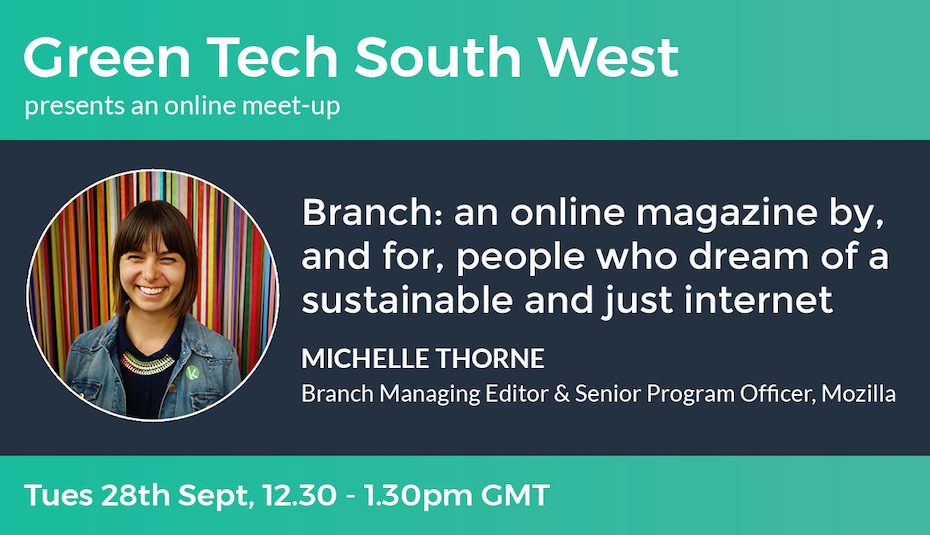Branch: an online magazine by and for people who dream of a sustainable internet
Green Tech South West are looking forward to welcome Michelle Thorne (Managing Editor) of Branch magazine to tell us all about the website, by and for people who dream of a sustainable and just internet.
Michelle will be joining us on Tuesday Sept 28th at 12.30pm and we caught up with her ahead of her talk.
Can you tell us more about Branch?
Michelle: Branch is an online magazine written by and for people who dream of a sustainable and just internet for all.
The internet is the worlds largest coal-powered machine. If we continue business-as-usual, the IT sector will be responsible for 14% of the worlds carbon emissions by 2040.
We believe that the internet must instead serve our collective liberation and ecological sustainability. That’s why we created Branch magazine.
The magazine is a space for personal reflection, critical engagement with technology and experimentation. This is our small attempt to uplift fresh thinking for how to green the web technically, aesthetically and politically. We strive to connect sustainability to root causes and to inequalities experienced at different intersections — gender, race, class, ability, and so on.
Branch magazine is a practice of collective imagination. There are fragments and fleeting glimpses. Sometimes there is simply a lingering sense of what should be.
Who is the magazine aimed towards?
Michelle: Creating change requires all kinds of practices — art and design, professional development, civic participation, policy and advocacy, imagination and positive visions for our future. This magazine is our small attempt to gather what inspires and challenges us and to publish that in the open.
We invited 50 wonderful people to share how they understand the climate impact of technology and how we might change it for the better. In this magazine, you will hear internet professionals — developers, designers, managers, executives, educators, policymakers, funders and artists — describe how they are greening their daily professional practice. You will see that there are very direct actions, such as switching computation to run on renewables. Yet there are deeper, systemic ways to green the internet that you will also find described here, and it is this practice that we seek to cultivate.
For deeper change to happen, internet professionals must understand the underlying structural issues of the climate crisis and its inequalities. We must go beyond tech solutionism and towards intersectional climate justice work.
Going forward we see the need to more develop interdisciplinary practices and tools for greening the internet. Mentorship and collaboration play a key role, as does supporting technologists on their climate journeys and closing the gaps in climate justice and digital rights efforts.
Can you give us an idea of some of the topics that have been covered so far?
Michelle:
Sustainable Interaction Design Principles
One Vision, One World. Whose World Then?
Repairing Our Relationship with Technology
10 Rules for Building a Low-Impact Website
AI and Climate Change: The Promise, the Perils and Pillars for Action
Climate Disinformation: A Beginners Guide
A Guide to Ecofriendly CryptoArt (NFTs)
The website is really green and low in emissions, was that a conscious decision with its design?
Michelle: To demonstrate these values, we created Branch as a carbon-aware website. It adapts to and reflects the physical infrastructure of the internet and the energy behind it. Utilising data from a grid intensity API and the users location, Branch has four different interface designs shown depending on the current energy demand and fossil fuels on the grid where the user is:
1. Lower grid demand, more renewables
2. Medium grid demand, fewer renewables
3. Higher grid demand, less renewables
4. Grid data unavailable
We collaborated with leading WordPress developers, including Green Tech SW’s own Hannah Smith, to produce the demand responsive code and then openly licensed it so others can make carbon-aware websites without needing to be a specialist developer.
The code is available on Github for anyone to use, repurpose and contribute to: https://github.com/climateaction-tech/branch-theme
We also intentionally worked in WordPress, one of the main blogging platforms on the internet, so that more people could experiment with these kinds of carbon-aware digital tools on their own sites.
Furthermore, the Branch site has been designed to be as low energy as possible. This includes using a limited number of fonts and utilizing system fonts, reducing image weight when they’re shown and designing in a way that doesn’t need lots of Javascript to render.
What has the response been so far to Branch?
Michelle: The first issue received 14,000 unique visitors and was made possible by EIT Climate KIC, Mozilla Foundation, Climate Action Tech, and The Green Web Foundation. And we just won the Ars Electronica Prize for Digital Humanity!
What are your plans for Branch going forward?
Michelle: Our next issue will come out in Nov, and we’re open for submissions as well as experiments for greening websites and the internet as a whole.
Thank you Michelle for the chat.
Michelle will take the virtual stage at our Green Tech SW meetup on Tuesday 28th of September at 12.30pm. Head over to the meetup page to RSVP for free. (https://www.meetup.com/GreenTech-South-West/events/279197352/)
